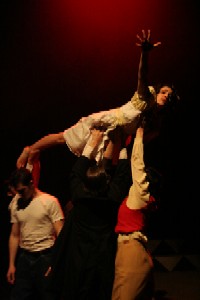| We Can't Reach You, Hartford |
 An investigative history of the Hartford Circus Fire of July 6th, 1944. Nominated for a Fringe First at the 2006 Edinburgh Fringe Festival. An investigative history of the Hartford Circus Fire of July 6th, 1944. Nominated for a Fringe First at the 2006 Edinburgh Fringe Festival. |
| Daguerreotype |
| In the twilight of his life, famed photographer Matthew Brady must choose between the life he has built and the legacy he wants to leave behind. |
| Tone Clusters |
| Renowned prose author Joyce Carol Oates explores honesty, perspective, and denial through one couple's harrowing attempt to save the person they love |
|
| Monday, June 25, 2007 |
| Radio Macbeth: the remix. |
I read Stephen's posting and I couldn't help but add a few thoughts sparked both by my experience of the play and by the recent posting on Parabasis about the relative merits of viewpointing.
While my experience with Viewpoints and Suzuki is fairly limited (one director I worked with used them as training with a limited crossover into our blocking work), I can understand Isaac's suspicion of a system that seems somewhat rigid in its ability to be copied and taught in workshops. While it seems to be intended as a training tool to build ensemble and awareness (again, speaking from limited experience), it seems hard, as many who respond to Isaac note, to not look at the work of the SITI company and try to discern vestiges of this famous method in the world of the play. In the case of Death and the Ploughman, I recognized blocking that appeared almost like open viewpointing on the set (I had just taken a brief workshop with the SITI company, so I was primed to this kind of exploration). It didn't resonate with me, perhaps because, as an audience member, I never felt let in to the inner logic of this movement system. It didn't seem anchored to anything else in the play. However, Radio Macbeth was different. While I often think of viewpoints as mostly a physical training method, the SITI actors seemed to use the concepts of tempo, duration, rhythm, etc. to both vocalize and physicalize all matter of internal anguish. Observing this, instead of feeling like a system, felt bold. Playing with these simple elements, whatever we want to call them, helped the actors to express more deeply. Therefore, I would amend what Stephen has said about these incredibly powerful scenes. It was not only the words (they were not quite stripped), but the facility of the actors in using the available resources in their own bodies and voices (really isn't that the true objective of this training?)—the sinking slowly into a chair, the thin wail, a brilliantly sinister coffee spoon—that revitalized this oft- read play. |
posted by Jess @ 1:11 AM  |
|
|
|
|
| Who We Are |
|
| Previous Posts |
|
| Archives |
|
| Our Kind of Theater |
|
| Reading Material |
|
|
